Exploring the Factors in the Discontinuation of a Talent Pool Information System: A Case Study of an EduTech Startup in Indonesia
Abstract
:1. Introduction
2. Literature Review
2.1. Information Systems’ Life Cycle
2.2. Discontinuance of Information System
2.3. Theories Relating to Decisions to Use an Information System
2.3.1. Theory of Reasoned Action (TRA)
2.3.2. Theory of Planned Behavior (TPB)
2.3.3. Expectation-Confirmation Model (ECM) Theory
2.4. Hedonic and Utilitarian Benefits of Information Systems
2.5. Company Profile
2.6. Research Method
2.7. Research Instruments
2.8. Research Participants
2.9. Participant Interviews
2.10. Data Analysis
3. Results
3.1. Experiential Factors
3.1.1. Poor System Quality
“Then it is still often found that the system case displays a blank page (just blank white without any information).”(R1 and R2)
“I’ve failed to log in once, even though I logged in with the same username and password.”(R4)
“In my opinion, it is still inaccurately displaying the data because I have found cases where I was looking for digital marketing talent, but what appeared was talent from product management”(R1 and R2)
“The obstacle I experienced while using this system was that the talent filtering feature often errs”(R1)
3.1.2. Information Issues
“in the skills dropdown on the filtering feature, there is a skill name category that appears double. Examples of Javascript and Javascript Programming.”(R3 and R4)
“but I think it can be improved again in terms of providing more talent data”(R2 and R5)
“I checked the talent database but it was not updated; all the old talents are still there.”(R2 and R4)
“and found many incomplete talent data (e.g.: CVs and resumes are not filled by talent)”(R1, R2, R4, and R5)
“But it’s unfortunate that for the skill section, there is less information provided on how deep the talent has experience for the skill. Example: 4/5 Javascript Skill”(R6)
3.1.3. Interface Issues
“Honestly, in terms of UI/UX Design, I think it’s still lacking; it looks too plain and less attractive”(R1)
“You see, I feel that the current design is indeed better than the talent pool system version 1, but there is still a lot of information displayed quite densely, and the font size is also too small”(R4)
“Then the appearance and color selection are less attractive”(R4 and R6)
“I prefer to use websites (in desktops) over mobile because I think the mobile display feels less neat when compared to desktops”(R7)
“Just put it from me in the talent explanation card; there are too many writings displayed.”(R3 and R6)
3.1.4. Unfamiliarity
“I’m a little confused when I see the job posting and talent interview features, maybe I’m not familiar with how it looks”(R5)
“At the beginning of use, I need to try the feature first, my fault is that I also didn’t open the guidebook.”(R6)
3.2. External Factors
3.2.1. Talent Mismatch
“Just now, there are still many talent databases, which are not in accordance with the requirements I need at this time.”(R1 and R5)
“Only a few in the talent databases fit the current needs.”(R1)
“Sometimes the talent is ok, but the background is lacking, for example, there are currently many job requirements with a minimum requirement of bachelor’s degree (S1), but in the system, it is more common to find high school/vocational graduates.”(R1, R2, R4, and R6)
3.2.2. Workforce Needs
“But unfortunately these few months the office has been in hiring freeze”(R7)
“Currently there is no open opportunity and the HR team also has other tasks so, yes, they did not access PT XYZ’s talent pool system.”(R6)
“But honestly, we rarely access the talent pool system because the demand for IT outsourcing is currently quite low.”(R1)
“…only sometimes there are external factors that requires fast talent data to fill positions in urgent companies, so it’s more convenient to ask for talent through admin talent support.”(R3, R4, R5, and R6)
3.2.3. Lack of Socialization
“To be honest, I rarely use PT XYZ’s talent pool system because I am not aware that this system was running as one of the work distribution programs from PT XYZ.”(R2)
“But it’s a pity that I just found out that there is information about the improvement of this talent pool system.”(R7)
“I was just confused because the talent support team of PT XYZ was often more responsive to give talent recommendations via spreadsheet compared to updating talent data in the system.”(R2)
4. Discussion
5. Conclusions, Implications, and Limitations
Author Contributions
Funding
Institutional Review Board Statement
Informed Consent Statement
Data Availability Statement
Conflicts of Interest
References
- Iivari, J. Why Are CASE Tools Not Used? Commun. ACM 1996, 39, 94–103. [Google Scholar] [CrossRef]
- Furneaux, B.; Wade, M.R.; Furneaux, B. Linked References Are Available on JSTOR for This Article: An Exploration of Organizational Level Information Systems Discontinuance Intentions1. MIS Q. 2018, 35, 573–598. [Google Scholar] [CrossRef]
- Jeyaraj, A.; Rottman, J.W.; Lacity, M.C. A Review of the Predictors, Linkages, and Biases in IT Innovation Adoption Research. J. Inf. Technol. 2006, 21, 1–23. [Google Scholar] [CrossRef]
- Bhattacherjee, A. ECM IS Model. MIS Q. 2011, 25, 351–370. [Google Scholar] [CrossRef]
- Kinnunen, J. Leaving the Lights On? Exploring Cloud ERP Migrations and IS Discontinuance. In Proceedings of the 2021 IEEE 12th Annual Ubiquitous Computing, Electronics & Mobile Communication Conference (UEMCON), New York, NY, USA, 1–4 December 2021; IEEE: Piscataway, NJ, USA, 2021; pp. 58–64. [Google Scholar] [CrossRef]
- Recker, J. Reasoning about Discontinuance of Information System Use. J. Inf. Technol. Theory Appl. 2016, 17, 41–66. [Google Scholar]
- Bian, Y.; Kang, L.; Zhao, J.L. Dual Decision-Making with Discontinuance and Acceptance of Information Technology: The Case of Cloud Computing. Internet Res. 2020, 30, 1521–1546. [Google Scholar] [CrossRef]
- Seran, T.; Gurau, C.; Pellegrin-Boucher, E. Information Systems’ Adoption in Meta-Organizations. Procedia Comput. Sci. 2022, 204, 440–447. [Google Scholar] [CrossRef]
- Wu, K.; Beydoun, G.; Sohaib, O.; Gill, A. The Co-Construct/Co-Evolving Process between Organization’s Absorptive Capacity and Enterprise System Practice under Changing Context: The Case of ERP Practice. Inf. Syst. Front. 2022, 24, 2123–2138. [Google Scholar] [CrossRef]
- Saeed, K.A.; Abdinnour, S. Understanding Post-Adoption IS Usage Stages: An Empirical Assessment of Self-Service Information Systems. Inf. Syst. J. 2013, 23, 219–244. [Google Scholar] [CrossRef]
- Dolmark, T.; Sohaib, O.; Beydoun, G.; Wu, K. The Effect of Individual’s Technological Belief and Usage on Their Absorptive Capacity towards Their Learning Behaviour in Learning Environment. Sustainability 2021, 13, 718. [Google Scholar] [CrossRef]
- Uddin, A.; Cetindamar, D.; Hawryszkiewycz, I.; Sohaib, O. The Role of Dynamic Cloud Capability in Improving SME’s Strategic Agility and Resource Flexibility: An Empirical Study. Sustainability 2023, 15, 8467. [Google Scholar] [CrossRef]
- Sohaib, O. Towards a Sustainable Digital Ecosystem: Exploring New Frontiers in Information Systems. Sustainability 2024, 16, 3511. [Google Scholar] [CrossRef]
- Rehman, J.; Hawryszkiewycz, I.; Sohaib, O.; Namisango, F.; Dahri, A.S. Towards the Knowledge-Smart Professional Service Firms: How High-Performance Work Systems Support the Transformation. J. Knowl. Econ. 2023, 14, 3640–3670. [Google Scholar] [CrossRef]
- Furneaux, B.; Wade, M. The End of the Information System Life: A Model of IS Discontinuance. Data Base 2010, 41, 45–69. [Google Scholar] [CrossRef]
- Mehrabioun Mohammadi, M.; Jalali, A.; Hasani, A. Success and Failure Factors in Implementing Quality Management Systems in Small- and Medium-Sized Enterprises: A Mixed-Method Study. Int. J. Qual. Reliab. Manag. 2022, 39, 468–494. [Google Scholar] [CrossRef]
- Ramayah, T.; Aafaqi, B. Intention to Shop Online amongst MBA Students: Comparing Theory of Reasoned Action (TRA) and the Technology Acceptance Model (TAM). In Proceedings of the APMC Conference, Suzhou, China, 4–7 December 2005; pp. 43–47. [Google Scholar]
- Ajzen, I.; Fishbein, M. Understanding Attitudes and Predicting Social Behavior; Pbk., Ed.; Prentice-Hall: Englewood Cliffs, NJ, USA, 1980; p. 278. ISBN 0139364439/9780139364433/0139364358/9780139364358. [Google Scholar]
- Bagozzi, R. The Self-Regulation of Attitudes, Intentions, and Behavior. Soc. Psychol. Q. 1992, 55, 178–204. [Google Scholar] [CrossRef]
- Glanz, K.; Rimer, B.K.; Viswanath, K.V. (Eds.) Theory, Research, and Practice in Health Behavior. In Health Behavior: Theory, Research, and Practice, 5th ed.; Jossey-Bass/Wiley: Hoboken, NJ, USA, 2015; pp. 23–41. [Google Scholar]
- Ajzen, I. The Theory of Planned Behavior. Organ. Behav. Hum. Decis. Process. 1991, 50, 179–211. [Google Scholar] [CrossRef]
- Oliver, R.L. A Cognitive Model of the Antecedents and Consequences of Satisfaction Decisions. J. Mark. Res. 1980, 17, 460. [Google Scholar] [CrossRef]
- Jin, X.L.; Zhou, Z.; Lee, M.K.O.; Cheung, C.M.K. Why Users Keep Answering Questions in Online Question Answering Communities: A Theoretical and Empirical Investigation. Int. J. Inf. Manag. 2013, 33, 93–104. [Google Scholar] [CrossRef]
- Hsu, C.L.; Lin, J.C.C. Effect of Perceived Value and Social Influences on Mobile App Stickiness and In-App Purchase Intention. Technol. Forecast. Soc. Change 2016, 108, 42–53. [Google Scholar] [CrossRef]
- Hsu, T.H.; Tang, J.W. Development of Hierarchical Structure and Analytical Model of Key Factors for Mobile App Stickiness. J. Innov. Knowl. 2020, 5, 68–79. [Google Scholar] [CrossRef]
- Alnawas, I.; Al Khateeb, A.; El Hedhli, K. The Effects of App-Related Factors on App Stickiness: The Role of Cognitive and Emotional App Relationship Quality. J. Retail. Consum. Serv. 2023, 75, 103412. [Google Scholar] [CrossRef]
- Lin, K.-Y.; Lu, H.-P. Why People Use Social Networking Sites: An Empirical Study Integrating Network Externalities and Motivation Theory. Comput. Human Behav. 2011, 27, 1152–1161. [Google Scholar] [CrossRef]
- Rose, S.; Clark, M.; Samouel, P.; Hair, N. Online Customer Experience in E-Retailing: An Empirical Model of Antecedents and Outcomes. J. Retail. 2012, 88, 308–322. [Google Scholar] [CrossRef]
- Cheng, Y.M. What Makes Learners Enhance Learning Outcomes in MOOCs? Exploring the Roles of Gamification and Personalization. Interact. Technol. Smart Educ. 2023, 21, 308–330. [Google Scholar] [CrossRef]
- Lin, P.Y.; Liang, T.P.; Huang, H.C.; Li, Y.W. Design Quality, Relationship Intimacy and Continuance Intention of Mobile Apps: An Extension To the Is Success Model. J. Electron. Commer. Res. 2021, 22, 266–284. [Google Scholar]
- Suryana, A. Metode Penelitian Metode Penelitian; Pusaka Jambi: Jambi, Indonesia, 2017; ISBN 9786025145339. [Google Scholar]
- Fauzy, A. Metode Sampling. Universitas Terbuka: Tangerang Selatan, Indonesia, 2019; Volume 9, ISBN 9781119130536. [Google Scholar]
- Taylor, S.J.; Bogdan, R. Introduction to Qualitative Research Methods: A Guidebook and Resource, 3rd ed.; John Wiley & Sons: Hoboken, NJ, USA, 1998; p. 337. [Google Scholar]
- Zhang, Y.; Rong, X.; Shu, M.; Chen, Q. Identification of Key Influencing Factors of User Experience of Mobile Reading APP in China Based on the Fuzzy-DEMATEL Model. Math. Probl. Eng. 2021, 2021, 2847646. [Google Scholar] [CrossRef]
- DeLone, W.H.; McLean, E.R. The DeLone and McLean Model of Information Systems Success: A Ten-Year Update. J. Manag. Inf. Syst. 2003, 19, 9–30. [Google Scholar] [CrossRef]
- Chen, C. Factors Affecting Online Chinese as a Foreign Language Learning Stickiness: A Study on International Students in China. Front. Psychol. 2022, 12, 803669. [Google Scholar] [CrossRef]
- Primiero, G. A Taxonomy of Errors for Information Systems. Minds Mach. 2014, 24, 249–273. [Google Scholar] [CrossRef]
- Elmasri, R.; Navathe, S.B. Database Systems, 7th ed.; Pearson: London, UK, 2016. [Google Scholar]
- Nasution, W.S.L.; Nusa, P. UI/UX Design Web-Based Learning Application Using Design Thinking Method. ARRUS J. Eng. Technol. 2021, 1, 18–27. [Google Scholar] [CrossRef]
- Choi, J.C. User Familiarity and Satisfaction with Food Delivery Mobile Apps. SAGE Open 2020, 10, 4. [Google Scholar] [CrossRef]
- Hu, Q.; Hart, P.; Cooke, D. The Role of External and Internal Influences on Information Systems Security—A Neo-Institutional Perspective. J. Strateg. Inf. Syst. 2007, 16, 153–172. [Google Scholar] [CrossRef]
- Uchida, Y. Education, Social Mobility, and Talent Mismatch; Springer: Berlin/Heidelberg, Germany, 2018. [Google Scholar]
- Al-Nabhani, K.; Wilson, A.; McLean, G. Examining Consumers’ Continuous Usage of Multichannel Retailers’ Mobile Applications. Psychol. Mark. 2022, 39, 168–195. [Google Scholar] [CrossRef]
- Hsu, C.L.; Chen, M.C. How Does Gamification Improve User Experience? An Empirical Investigation on the Antecedences and Consequences of User Experience and Its Mediating Role. Technol. Forecast. Soc. Change 2018, 132, 118–129. [Google Scholar] [CrossRef]
- Yang, R.; Wibowo, S.; Mubarak, S.; Rahamathulla, M. Managing Students’ Attitude, Learning Engagement, and Stickiness towards e-Learning Post-COVID-19 in Australian Universities: A Perceived Qualities Perspective. J. Mark. High. Educ. 2023, 1–32. [Google Scholar] [CrossRef]
- Roca, J.C.; Chiu, C.M.; Martínez, F.J. Understanding E-Learning Continuance Intention: An Extension of the Technology Acceptance Model. Int. J. Hum. Comput. Stud. 2006, 64, 683–696. [Google Scholar] [CrossRef]
- Rumambi, F.R.; Santoso, A.J.; Setyohadi, D.B. Identification of Factors Influencing the Success of Hospital Information System (SIRS) by Hot-Fit Model 2006: A Case Study of RSUD Dr Samratulangi Tondano, Minahasa Regency, North Sulawesi. In Proceedings of the 2017 International Conference on Soft Computing, Intelligent System and Information Technology (ICSIIT), Bali, Indonesia, 26–29 September 2017; pp. 202–207. [Google Scholar] [CrossRef]
- Elsotouhy, M.M.; Ghonim, M.A.; Alasker, T.H.; Khashan, M.A. Investigating Health and Fitness App Users’ Stickiness, WOM, and Continuance Intention Using S-O-R Model: The Moderating Role of Health Consciousness. Int. J. Hum. Comput. Interact. 2022, 40, 1235–1250. [Google Scholar] [CrossRef]
- Li, M.; Luo, C. Exploring the Influencing Factors of User Stickiness in a Chinese Mobile News Application. In Proceedings of the 7th International Conference on Management of e-Commerce and e-Government, Buenos Aires, Argentina, 22–24 April 2020; pp. 119–124. [Google Scholar]
- Dastane, O.; Haba, H.F. What Drives Mobile MOOC’s Continuous Intention? A Theory of Perceived Value Perspective. Int. J. Inf. Learn. Technol. 2023, 40, 148–163. [Google Scholar] [CrossRef]
- Irianing Tyas, E.; Satia Darma, E. Pengaruh Perceived Usefulness, Perceived Ease of Use, Perceived Enjoyment, Dan Actual Usage Terhadap Teknologi Informasi: Studi Empiris Pada Bagian Akuntansi Dan Keuangan Baitul Maal Tamwil Wilayah Daerah Istimewa Yogyakarta Dan. Reviu Akunt. Dan Bisnis Indones. 2017, 1, 25–35. [Google Scholar]
- Smith, T.J. Senior Citizens and E-Commerce Websites: The Role of Perceived Usefulness, Perceived Ease of Use, and Web Site Usability. Informing Sci. 2008, 11, 59–83. [Google Scholar] [CrossRef]
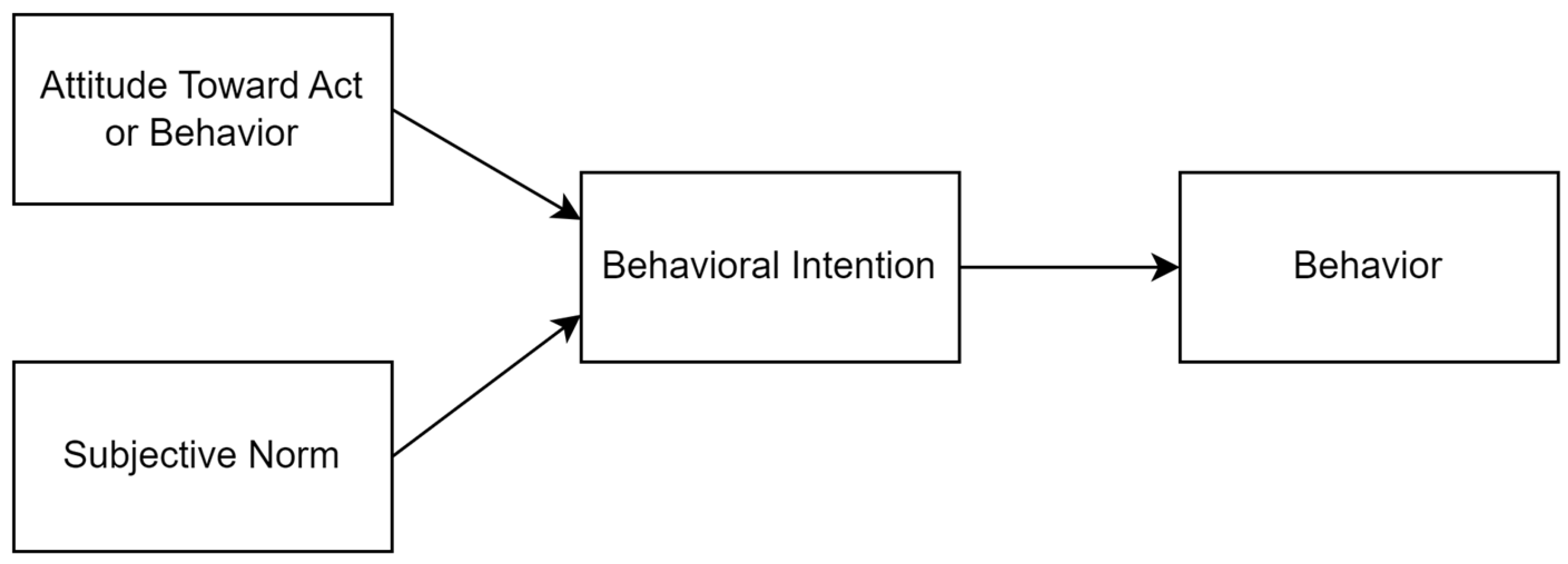
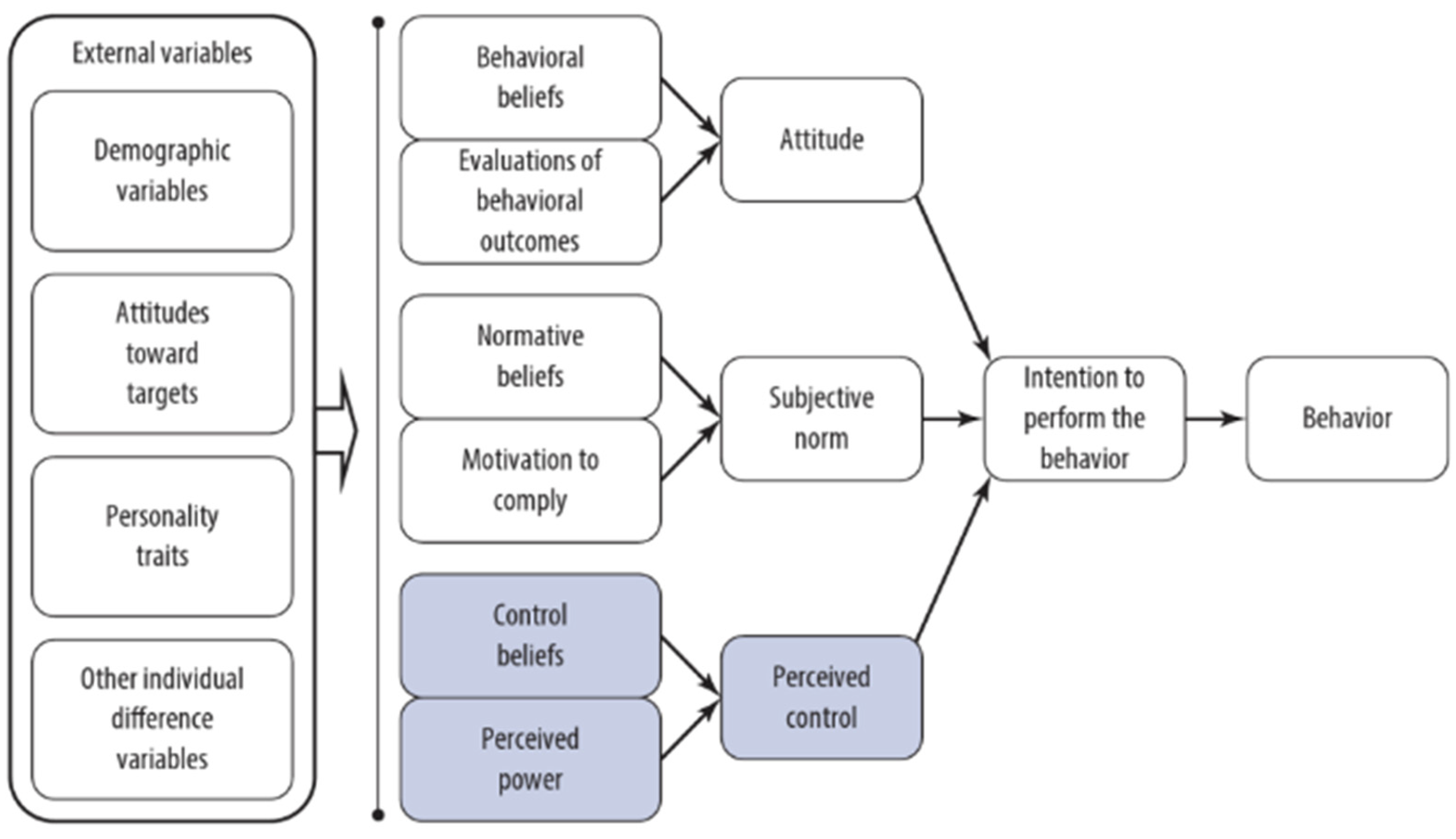
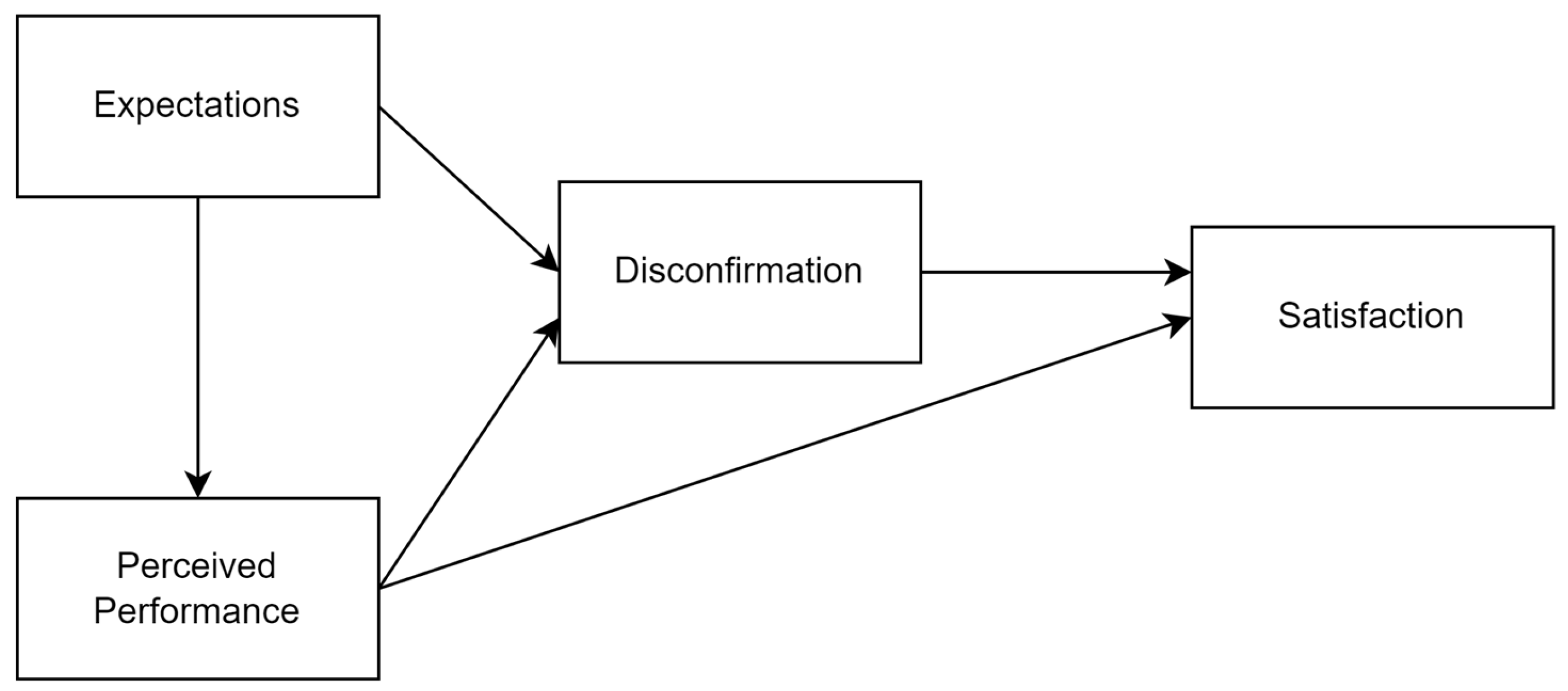
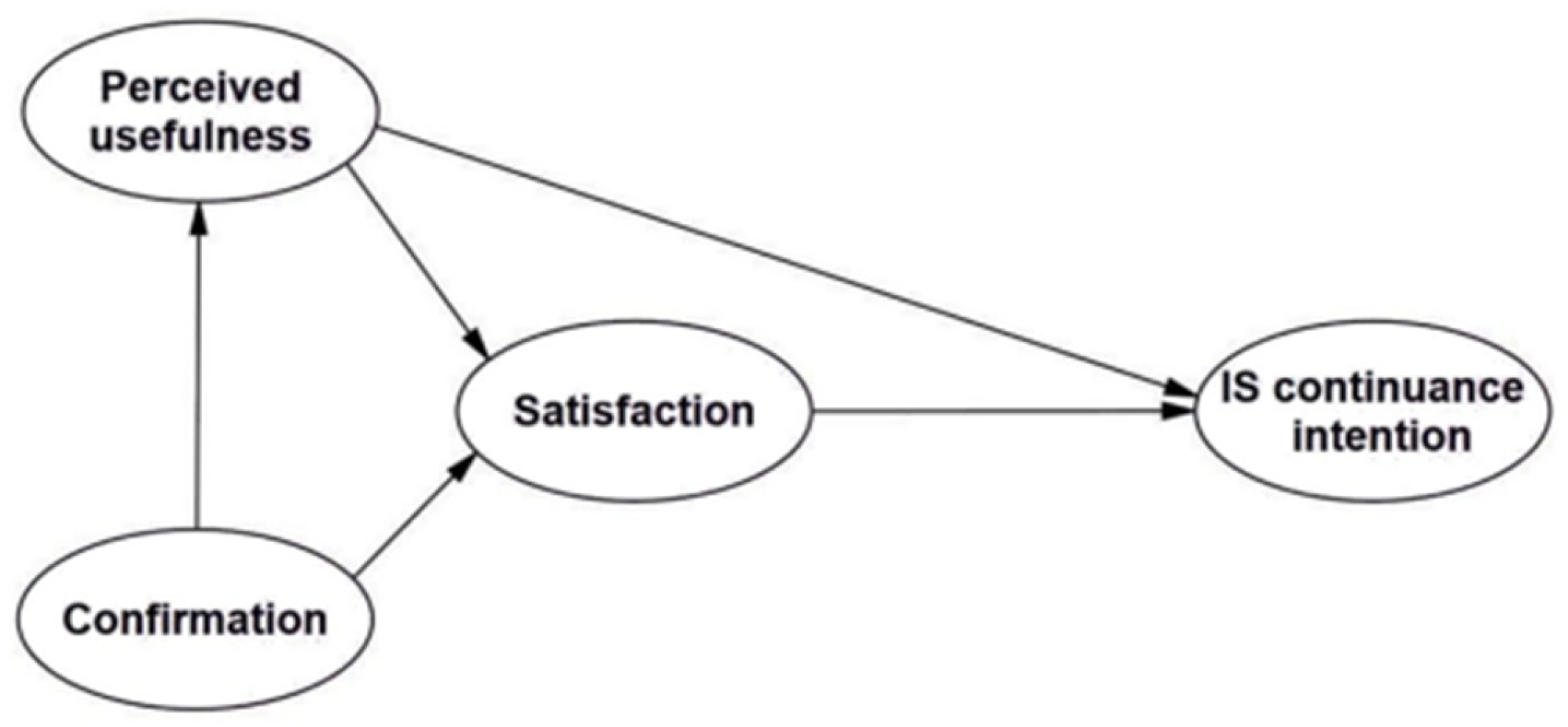
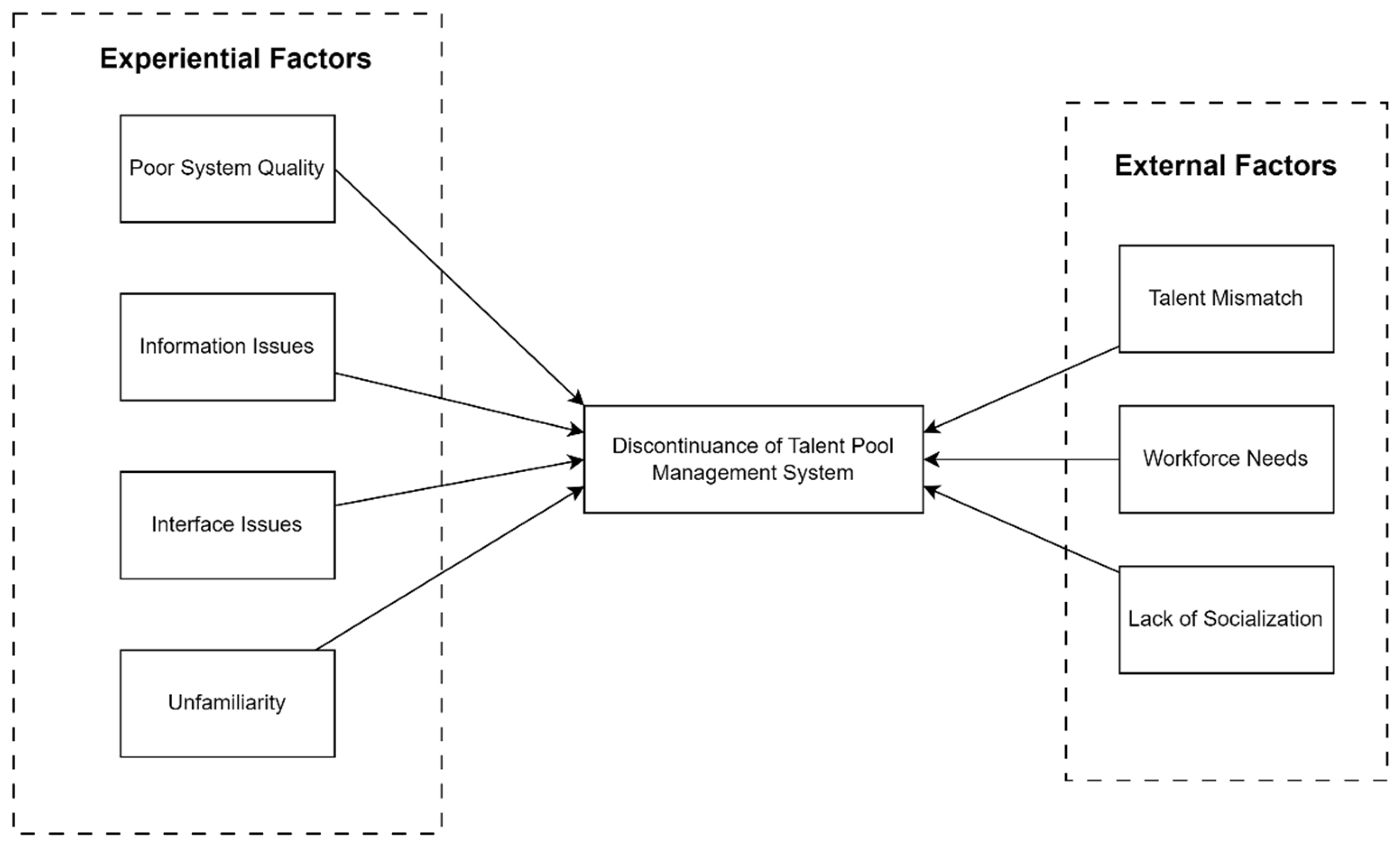
| No | Questionnaire Questions | Theme Construct | References | Reason |
|---|---|---|---|---|
| 1 | Do you use a PT XYZ’s talent pool system for talent search? | Usage Continuance | [4,6,7] | To identify the relationship between individuals’ use of the talent pool system and their intention to continue using it. |
| 2 | How often do you access the PT XYZ’s talent pool system? | Usage Continuance | [4,6,7] | |
| 3 | In your opinion, can PT XYZ’s talent pool system help in the search for talent data? | Perceived usefulness | [6] | To analyze individual perceptions regarding the level of usefulness of the talent pool system. |
| 4 | Does the use of the PT XYZ’s system help you to do your job? | Perceived Usefulness | [6] | |
| 5 | Is the talent search process using the PT XYZ’s talent pool system easier for your work when compared to using spreadsheets? | Perceived Usefulness | [6] | |
| 7 | Can you easily search for talent that matches the job requirements through the talent search feature in the PT XYZ’s talent pool system? | Perceived Ease of Use | [6] | To understand users’ opinions about how easy it is to operate the features of the talent pool system. |
| 6 | Do you find it difficult to use the PT XYZ’s talent system? | Perceived Ease of Use | [6] | |
| 8 | Can you easily use the interview invitation feature for talents? | Perceived Ease of Use | [6] | |
| 9 | Are you having trouble using the interview invitation feature for talent? | Perceived Ease of Use | [6] | |
| 10 | Do you experience confusion when you first access/use PT XYZ’s talent pool system? | Perceived Ease of Use | [6] | |
| 11 | Have you ever experienced difficulties or encountered errors in using the PT XYZ’s talent pool system? | System Reliability | [7] | To analyze individual perceptions of trust in the reliability of the talent pool system, including regarding the speed of information processing and information that meets user needs. |
| 12 | Do you think this system can be trusted to conduct accurate talent searches according to job descriptions? | System Reliability | [7] | |
| 13 | Have you ever encountered errors related to system performance during the use of PT XYZ’s talent pool? (Example:system downs, failed logins, and the searched talent data did not appear.) | System Reliability | [7] | |
| 14 | Do you think the appearance of the PT XYZ’s talent pool system is now comfortable to use, whether accessed via desktop or mobile devices? | System Compatibility | [7] | To ensure how well the talent pool system suits the devices and applications that users usually use, because this affects user satisfaction and the usability of the system. |
| 15 | Is the output data from PT XYZ’s system directly and quickly generated without delay when you use it? | Confirmation | [4] | To ensure functional aspects of the talent pool system. |
| 16 | How compatible is the system’s ability to display talent data with the job requirements needed by the company (company partner)? | Confirmation | [4] | |
| 17 | Do you have any insecurity related to data privacy when accessing PT XYZ’s talent pool system? | Information Security Threats | [6,7] | To identify individual trust in the talent pool system in relation to possible risks regarding data security. |
| 18 | Do you change your company partner account’s password regularly? | Information Security Threats | [6,7] | |
| 19 | Do you give company partner account access to HR/Other Co-workers? | Information Security Threats | [6,7] | |
| 20 | Do you have any input related to PT XYZ’s talent pool system? | (Open Ended Question) | - | To collect suggestions and feedback from users about the talent pool system. |
| 21 | If you could provide one feature that could help your team’s work, what would it be and why? | (Open Ended Question) | - |
| No | Participant Code | Role | Age | Gender | Company Field |
|---|---|---|---|---|---|
| 1 | R1 | IT Talent Recruiter and Acquirer | 24 y.o | Female | IT Outsource and Service |
| 2 | R2 | IT Talent Acquirer | 25 y.o | Female | IT Outsource and Service |
| 3 | R3 | IT Talent Recruiter | 27 y.o | Male | Property Management |
| 4 | R4 | IT Talent Recruiter | 24 y.o | Male | IT Outsource and Service |
| 5 | R5 | IT Talent Acquirer | 37 y.o | Female | Clinics and Beauty Products |
| 6 | R6 | IT Talent Acquirer | 40 y.o | Male | IT Service SaaS HR and Finance |
| 7 | R7 | IT Talent Acquirer | 20 y.o | Female | IT Software House |
| Dimension | Construct | Description |
|---|---|---|
| Experiential Factors | Poor System Quality | Conditions wherein an information system does not meet expected or desired standards regarding performance, reliability, ease of use, or other relevant aspects. |
| Information Issues | Conditions in which the information provided by an information system does not meet the expected or desired standards. | |
| Interface Issues | Problems or challenges related to the user interface of a system or product. | |
| Unfamiliarity | Conditions wherein someone is unfamiliar with the workings, interface, or features of the system. | |
| External Factors | Talent Mismatch | Situations where an individual’s skills, knowledge, or levels of experience do not match the job’s requirements. |
| Workforce Needs | The organization’s need for a certain number of workers | |
| Lack of Socializations | Lack of interaction or involvement of organizations or individuals related to training in using available systems or technologies. |
| No | Construct | Frequency |
|---|---|---|
| 1 | Poor System Quality | 4 |
| 2 | Information Issues | 5 |
| 3 | Interface Issues | 8 |
| 4 | Unfamiliarity | 2 |
| 5 | Talent Mismatch | 3 |
| 6 | Workforce Needs | 6 |
| 7 | Lack of Socialization | 2 |
Disclaimer/Publisher’s Note: The statements, opinions and data contained in all publications are solely those of the individual author(s) and contributor(s) and not of MDPI and/or the editor(s). MDPI and/or the editor(s) disclaim responsibility for any injury to people or property resulting from any ideas, methods, instructions or products referred to in the content. |
© 2024 by the authors. Licensee MDPI, Basel, Switzerland. This article is an open access article distributed under the terms and conditions of the Creative Commons Attribution (CC BY) license (https://creativecommons.org/licenses/by/4.0/).
Share and Cite
Nurwardani, S.; Zayyan, A.; Astuti, E.F.; Putra, P.O.H. Exploring the Factors in the Discontinuation of a Talent Pool Information System: A Case Study of an EduTech Startup in Indonesia. Information 2024, 15, 412. https://doi.org/10.3390/info15070412
Nurwardani S, Zayyan A, Astuti EF, Putra POH. Exploring the Factors in the Discontinuation of a Talent Pool Information System: A Case Study of an EduTech Startup in Indonesia. Information. 2024; 15(7):412. https://doi.org/10.3390/info15070412
Chicago/Turabian StyleNurwardani, Sabila, Ailsa Zayyan, Endah Fuji Astuti, and Panca O. Hadi Putra. 2024. "Exploring the Factors in the Discontinuation of a Talent Pool Information System: A Case Study of an EduTech Startup in Indonesia" Information 15, no. 7: 412. https://doi.org/10.3390/info15070412






